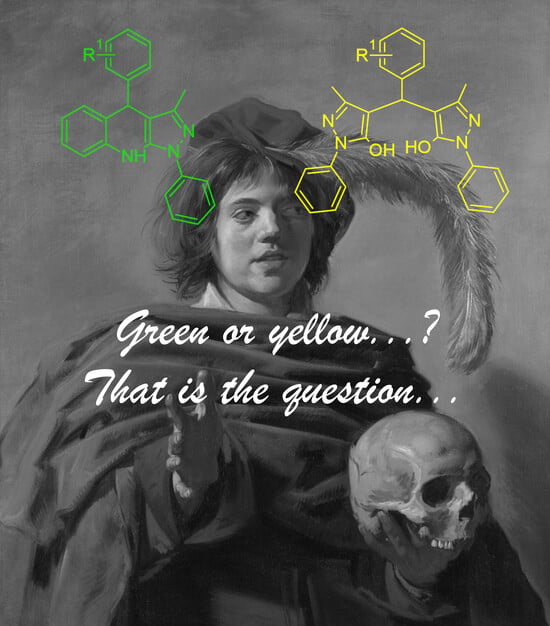Multicomponent Synthesis of 4-Aryl-4,9-dihydro-1H-pyrazolo[3,4-b]quinolines Using L-Proline as a Catalyst—Does It Really Proceed?
Abstract
1. Introduction
2. Results and Discussion
3. Materials and Methods
3.1. Chemicals and Instruments
3.2. Experimental Procedures
3.2.1. An Attempt at the Synthesis of 4-Aryl-1-phenyl-3-methyl-4,9-dihydro-1H-pyrazolo[3,4-b]quinolines via a Three-Component Reaction According to the Hegde and Shetty Protocol
3.2.2. A Synthesis of Selected 4,4′-(4-Arylmethylene)-bis-(3-methyl-1-phenylpyrazol-5-oles) from Aldehydes 2 and 5-Methyl-2-phenyl-2,4-dihydro-3H-pyrazole-3-one 6b—General Procedure
3.2.3. Synthesis of 4-Aryl-4,9H-dihydro-3-methyl-1-phenyl-1H-pyrazolo[3,4-b]quinolines 13 by Cyclisation of 3-Methyl-N,1-diphenyl-1H-pyrazol-5-amine 19 with Aldehydes 2
4. Conclusions
Supplementary Materials
Author Contributions
Funding
Institutional Review Board Statement
Informed Consent Statement
Data Availability Statement
Conflicts of Interest
References
- Willstätter, R., III. Synthese des Tropans und Tropidins. Ann. Chem. Pharm. 1901, 317, 307–374. [Google Scholar] [CrossRef]
- Birch, A.J. Investigating a scientific legend: The tropinone synthesis of Sir Robert Robinson, F.R.S. Notes Rec. R. Soc. Lond. 1993, 47, 277–296. [Google Scholar] [CrossRef]
- Strecker, A. Ueber einen neuen aus Aldehyd—Ammoniak und Blausäure entstehenden Körper. Ann. Chem. Pharm. 1854, 91, 349–351. [Google Scholar] [CrossRef]
- Mannich, C.; Krösche, W. Ueber ein Kondensationsprodukt aus Formaldehyd, Ammoniak und Antipyrin. Arch. Pharm. Pharm. Med. Chem. 1912, 250, 647–667. [Google Scholar] [CrossRef]
- Jiang, B.; Rajale, T.; Wever, W.; Tu, S.-J.; Li, G. Multicomponent reactions for the synthesis of heterocycles. Chem. Asian J. 2010, 5, 2318–2335. [Google Scholar] [CrossRef] [PubMed]
- Graebin, C.S.; Ribeiro, F.V.; Rogério, K.R.; Kümmerle, A.E. Multicomponent Reactions for the Synthesis of Bioactive Compounds: A Review. Curr. Org. Synth. 2019, 16, 855–899. [Google Scholar] [CrossRef]
- Insuasty, D.; Castillo, J.; Becerra, D.; Rojas, H.; Abonia, R. Synthesis of Biologically Active Molecules through Multicomponent Reactions. Molecules 2020, 25, 505. [Google Scholar] [CrossRef] [PubMed]
- Zhi, S.; Ma, X.; Zhang, W. Consecutive multicomponent reactions for the synthesis of complex molecules. Org. Biomol. Chem. 2019, 17, 7632–7650. [Google Scholar] [CrossRef] [PubMed]
- Danel, A.; Gondek, E.; Kucharek, M.; Szlachcic, P.; Gut, A. 1H-Pyrazolo[3,4-b]quinolines: Synthesis and Properties over 100 Years of Research. Molecules 2022, 27, 2775. [Google Scholar] [CrossRef] [PubMed]
- Quiroga, J.; Insuasty, B.; Hormaza, A.; Saitz, C.; Jullian, C. Synthesis of 4-aryl-4,7,8,9-tetrahydro-6H-pyrazolo[3,4-b]quinolin-5-ones. J. Heterocycl. Chem. 1998, 35, 575–578. [Google Scholar] [CrossRef]
- Chaczatrian, K.; Chaczatrian, G.; Danel, A.; Tomasik, P. A Facile Synthesis of 4-Aryl-1H-pyrazolo[3,4-b]quinolines. ChemInform 2004, 35, 2163. [Google Scholar] [CrossRef]
- Ren, Y.-M.; Jin, S.; Yan, H.-J.; Zhang, Z. PEG1000-Based Dicationic Acidic Ionic Liquid Catalyzed One-Pot Synthesis of 4-Aryl-3-Methyl-1-Phenyl-1H-Benzo[h]pyrazolo[3,4-b]quinoline-5,10-Diones via Multicomponent Reactions. Catalysts 2015, 5, 1649–1656. [Google Scholar] [CrossRef]
- Wu, L.-Q.; Dong, R.-Y.; Yang, C.-G.; Yan, F.-L. Synthesis of 4-Aryl-3-Methyl-1-Phenyl-1 H -Benzo[h]Pyrazolo[3,4-b]Quinoline-5,10-diones Using Diammonium Hydrogen Phosphate as an Efficient and Versatile Catalyst in Water. J. Chin. Chem. Soc. 2010, 57, 19–23. [Google Scholar] [CrossRef]
- Vachan, B.S.; Karuppasamy, M.; Vinoth, P.; Vivek Kumar, S.; Perumal, S.; Sridharan, V.; Menéndez, J.C. Proline and its Derivatives as Organocatalysts for Multi-Component Reactions in Aqueous Media: Synergic Pathways to the Green Synthesis of Heterocycles. Adv. Synth. Catal. 2020, 362, 87–110. [Google Scholar] [CrossRef]
- Patel, A.J.; Patel, V.C.; Dholakia, A.B.; Patel, D.S. L-Proline Catalyzed Synthesis of Heterocycles: A Review. Org. Prep. Proced. Int. 2023, 55, 487–513. [Google Scholar] [CrossRef]
- Gadkari, Y.U.; Shanbhag, R.D.; Telvekar, V.N. An Efficient One-Pot, Multicomponent Synthesis of 1, 3-Thiazolidin-4- Ones Using L-Proline as Catalyst in Water. Lett. Org. Chem. 2022, 19, 9–13. [Google Scholar] [CrossRef]
- Karamthulla, S.; Pal, S.; Parvin, T.; Choudhury, L.H. L-proline catalyzed multicomponent reactions: Facile access to 2H-benzo[g]pyrazolo[3,4-b]quinoline-5,10(4H,11H)-dione derivatives. RSC Adv. 2014, 4, 15319–15324. [Google Scholar] [CrossRef]
- Hegde, H.; Shetty, N.S. Facile one-pot multicomponent synthesis of 1H-pyrazolo[3,4-b]quinolines using L-proline as a catalyst. Chem. Heterocycl. Comp. 2017, 53, 883–886. [Google Scholar] [CrossRef]
- Casadia, I.; de Albuquerque, D.Y.; Carmo Capiotto, A.d.; Pereira de Pereira, C.M.; Pizzuti, L. Oxidative Aromatization of Pyrazolines. Curr. Org. Synth. 2017, 14, 691–703. [Google Scholar] [CrossRef]
- Jenkins, R.N.; Hinnant, G.M.; Bean, A.C.; Stephens, C.E. Aerobic aromatization of 1,3,5-triarylpyrazolines in open air and without catalyst. Arkivoc 2015, 2015, 347–353. [Google Scholar] [CrossRef]
- Nakamichi, N.; Kawashita, Y.; Hayashi, M. Oxidative aromatization of 1,3,5-trisubstituted pyrazolines and Hantzsch 1,4-dihydropyridines by Pd/C in acetic acid. Org. Lett. 2002, 4, 3955–3957. [Google Scholar] [CrossRef] [PubMed]
- Rurack, K.; Danel, A.; Rotkiewicz, K.; Grabka, D.; Spieles, M.; Rettig, W. 1,3-Diphenyl-1H-pyrazolo[3,4-b]quinoline: A versatile fluorophore for the design of brightly emissive molecular sensors. Org. Lett. 2002, 4, 4647–4650. [Google Scholar] [CrossRef]
- Tomasik, D.; Tomasik, P.; Abramovitch, R.A. Friedländer condensation of 1 H-pyrazolin-5-ones with O-aminobenzaldehydes. Synthesis of 1 H-pyrazolo[3,4-b]quinolines. J. Heterocycl. Chem. 1983, 20, 1539–1543. [Google Scholar] [CrossRef]
- Song, Q.-W.; Yu, B.; Liu, A.-H.; He, Y.; Yang, Z.-Z.; Diao, Z.-F.; Song, Q.-C.; Li, X.-D.; He, L.-N. PEG400-enhanced synthesis of gem-dichloroaziridines and gem-dichlorocyclopropanes via in situ generated dichlorocarbene. RSC Adv. 2013, 3, 19009. [Google Scholar] [CrossRef]
- Hennig, L.; Alva-Astudillo, M.; Mann, G.; Kappe, T. New aspects in the reaction of azomethines with cyclic CH-acidic compounds. Monatsh. Chem. 1992, 123, 571–579. [Google Scholar] [CrossRef]
- Mohammadi, M.; Ghorbani-Choghamarani, A. Hercynite silica sulfuric acid: A novel inorganic sulfurous solid acid catalyst for one-pot cascade organic transformations. RSC Adv. 2022, 12, 26023–26041. [Google Scholar] [CrossRef] [PubMed]
- Phatangare, K.R.; Padalkar, V.S.; Gupta, V.D.; Patil, V.S.; Umape, P.G.; Sekar, N. Phosphomolybdic Acid: An Efficient and Recyclable Solid Acid Catalyst for the Synthesis of 4,4′-(Arylmethylene)bis(1H-pyrazol-5-ols). Synth. Commun. 2012, 42, 1349–1358. [Google Scholar] [CrossRef]
- Eskandari, K.; Karami, B.; Khodabakhshi, S. An Unexpected Catalytic Synthesis of Novel and Known Bis(Pyrazolyl) Methanes by the use of α -aryl- N -phenyl Nitrones in Aqueous Media. J. Chem. Res. 2014, 38, 600–603. [Google Scholar] [CrossRef]
- Tamoradi, T.; Mousavi, S.M.; Mohammadi, M. Synthesis of a new Ni complex supported on CoFe2O4 and its application as an efficient and green catalyst for the synthesis of bis(pyrazolyl)methane and polyhydroquinoline derivatives. New J. Chem. 2020, 44, 8289–8302. [Google Scholar] [CrossRef]
- Keshavarz, M.; Vafaei-Nezhad, M. Design and Characterization of l-Prolinate-Amberlite as a Novel Heterogeneous Organocatalyst and Its Catalytic Application in the Synthesis of Pyrazol-Derivates. Catal. Lett. 2016, 146, 353–363. [Google Scholar] [CrossRef]
- Michaelis, A. Über 5-Aminopyrazole und über Iminopyrine. I. Über substituierte 5-Iminopyrazolone und über 5-Aminopyrazole. Ann. Chem. Pharm. 1911, 385, 1–43. [Google Scholar] [CrossRef]
- Danel, A.; Chaczatrian, K.; Tomasik, P. Microwave-assisted, facile route to 1H-pyrazolo[3,4-b]quinolines. Arkivoc 2000, 2000, 51–57. [Google Scholar] [CrossRef]
- Keshavarz, M.; Zarei Ahmady, A.; Vaccaro, L.; Kardani, M. Non-Covalent Supported of l-Proline on Graphene Oxide/Fe3O4 Nanocomposite: A Novel, Highly Efficient and Superparamagnetically Separable Catalyst for the Synthesis of Bis-Pyrazole Derivatives. Molecules 2018, 23, 330. [Google Scholar] [CrossRef] [PubMed]
- Gouda, M.A.; Al-Balawi, M.M.M.; Abu-Hashem, A.A. One-pot pseudo five-component synthesis and antioxidant evaluation of 4,4′-(aryl-methylene)bis(3-methyl-1-phenyl-1H-pyrazol-5-ol). Eur. J. Chem. 2016, 7, 363–367. [Google Scholar] [CrossRef]
- Thummar, B.B.; Tarpada, U.P.; Raval, D.K. Study on One-pot Biginelli-like Synthesis of Pyrazolo[3,4-d]pyrimidines in Bronsted Acidic Ionic Liquid Under Sonication and its Mechanism. J. Heterocycl. Chem. 2014, 51, 1740–1746. [Google Scholar] [CrossRef]
- Worrall, D.E. the addition of 1,3-diketones to isothiocyanates. I. Acetylacetone and certain aryl isothiocyanates. J. Am. Chem. Soc. 1920, 42, 1055–1061. [Google Scholar] [CrossRef]
- Borisevich, A.N.; Pel’kis, P.S. Arylamides of substituted thioacetic acids. Chem. Heterocycl. Comp. 1972, 5, 237–239. [Google Scholar] [CrossRef]
- Khachatryan, K.; Boszczyk, W.; Tomasik, P. Optical Properties of Some 4-Aryl-1H-pyrazolo[3,4-b]quinolines. ChemInform 2006, 37. [Google Scholar] [CrossRef]




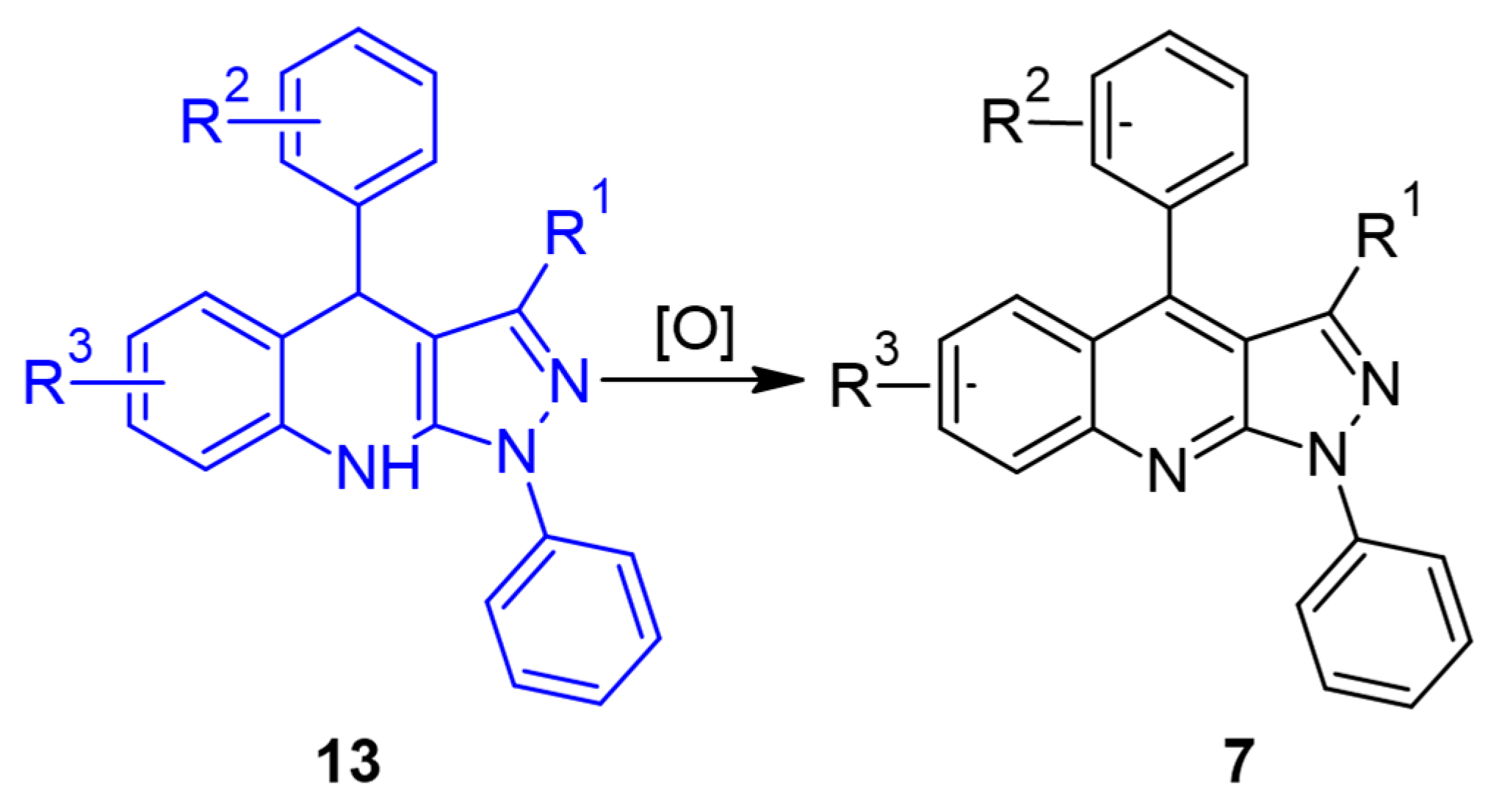



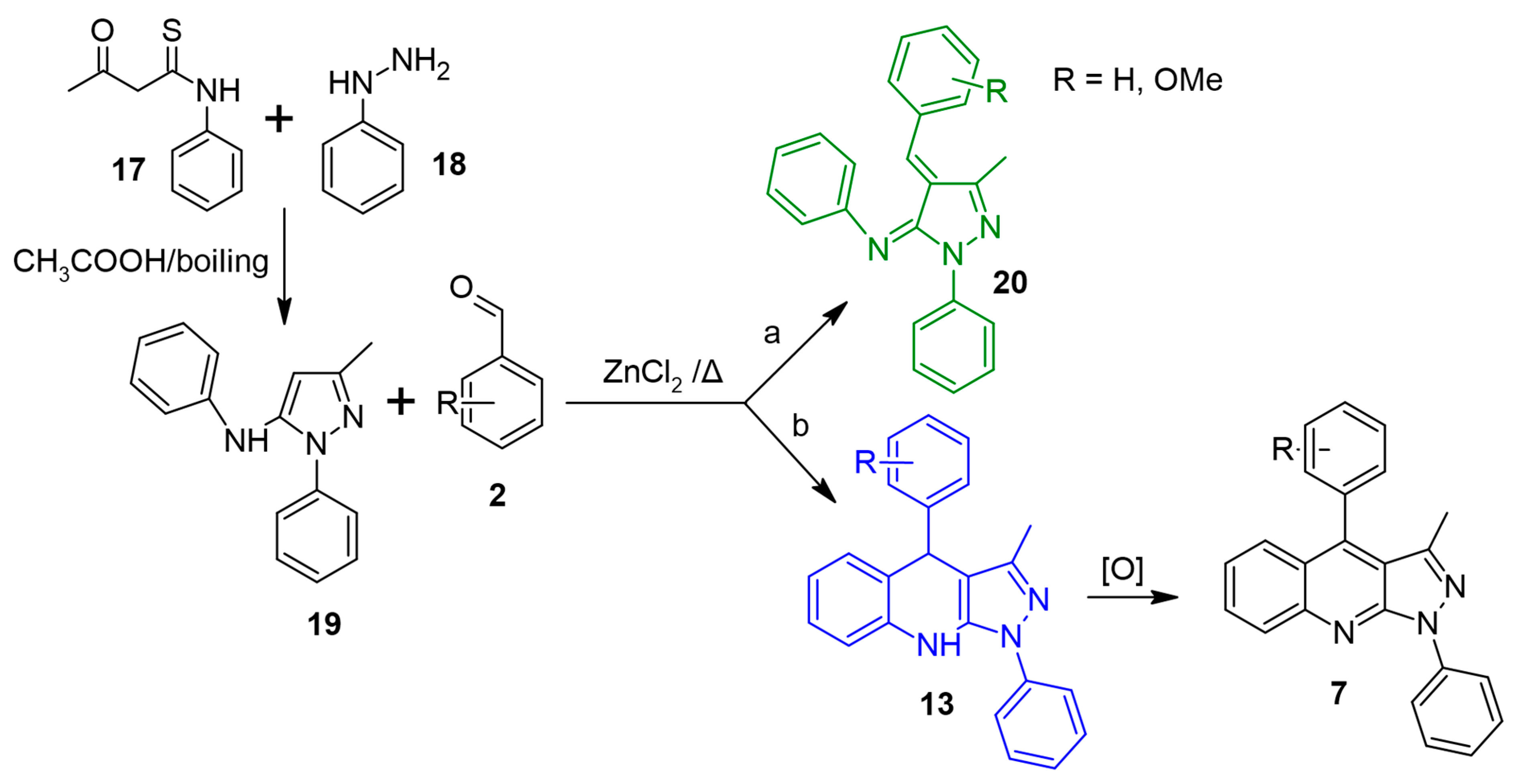
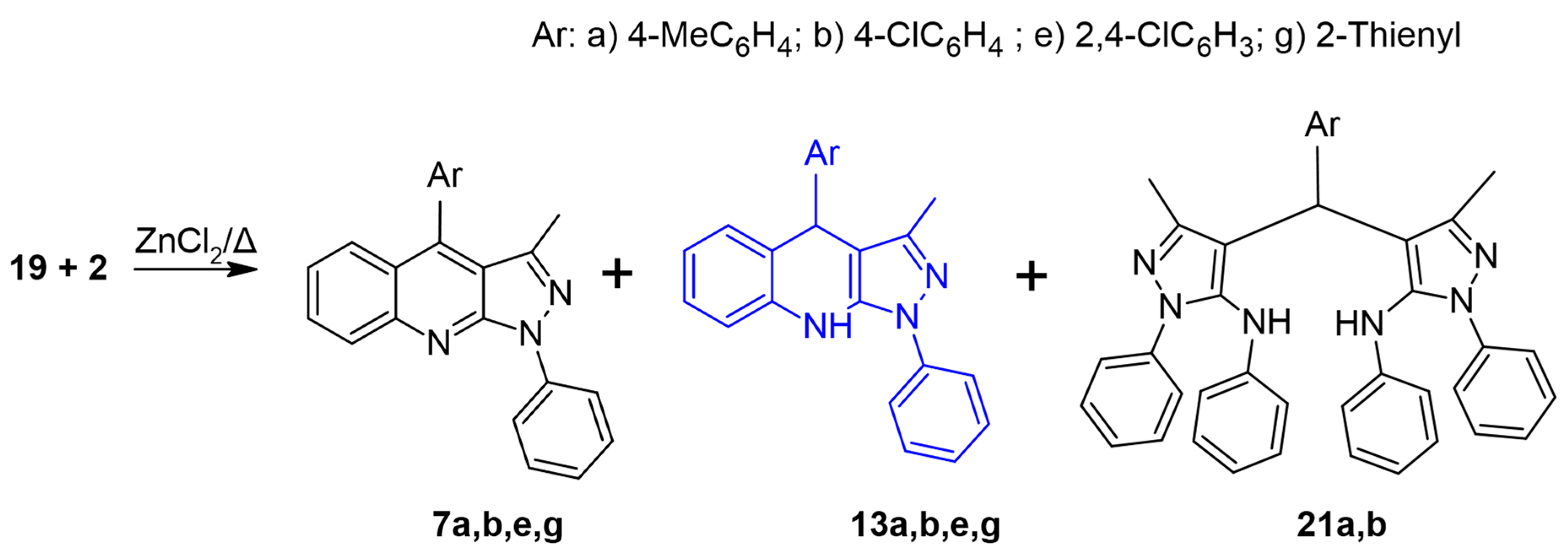

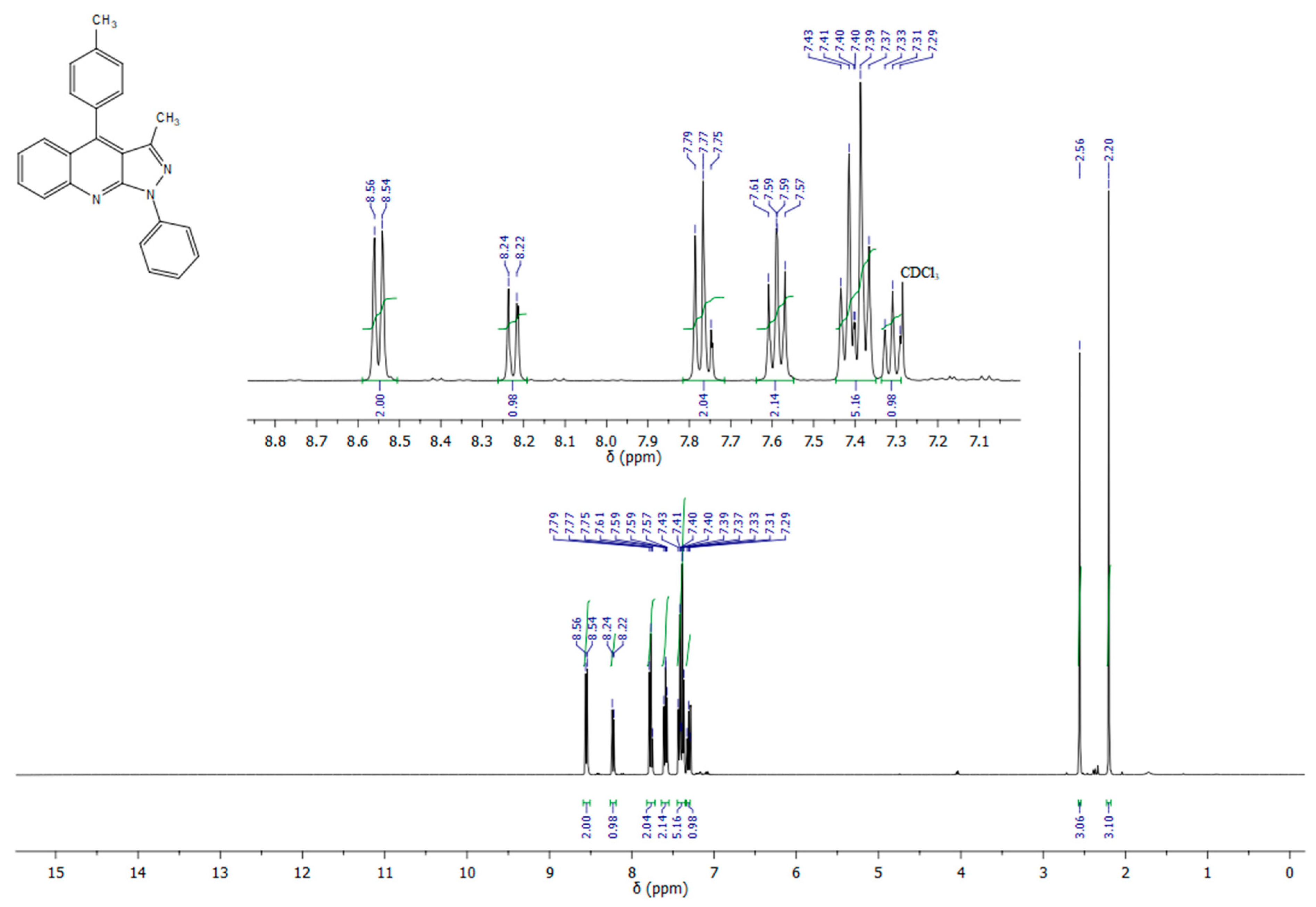
| Ar | “4-Aryl-4,9-dihydro-1H-pyrazolo[3,4-b]quinoline” 13 [18] | 4,4′-(Arylenemethylene)-bis-(3-methyl-1-phenyl-pyrazol-5-ol) 14 | ||
|---|---|---|---|---|
| N-H | C-H | O-H | C-H | |
| MeC6H4- | 14.00 | 4.89 | 13.94; 12.44 | 4.92 [26] |
| ClC6H4- | 13.90 | 4.96 | 13.89; 12.53 | 4.98 [26] |
| FC6H4- | 13.92 | 4.77 | 13.70 | 4.94 [27] |
| MeOC6H4- | 13.92 | 4.96 | 13.89 | 5.09 [27] |
| 2,4-ClC6H3- | 13.93 | 5.09 | 13.95; 12.67 | 5.05 [28] |
| NO2C6H4- | 13.03 | 4.96 | 13.90; 12.49 | 5.14 [28] |
| 3,4-OMeC6H3- | 13.92 | 4.89 | 14.11; 11.68 | 4.91 [29] |
| 4-OHC6H4 | 13.92 | 4.98 | 13.96; 12.2 | 4.86 [30] |
| Thiophen-2-yl | 13.91 | 4.96 | 14.01; 12.51 | 5.14 [26] |
| Furan-2-yl | 13.89 | 4.96 | 13.24 | 5.01 [27] |
Disclaimer/Publisher’s Note: The statements, opinions and data contained in all publications are solely those of the individual author(s) and contributor(s) and not of MDPI and/or the editor(s). MDPI and/or the editor(s) disclaim responsibility for any injury to people or property resulting from any ideas, methods, instructions or products referred to in the content. |
© 2023 by the authors. Licensee MDPI, Basel, Switzerland. This article is an open access article distributed under the terms and conditions of the Creative Commons Attribution (CC BY) license (https://creativecommons.org/licenses/by/4.0/).
Share and Cite
Danel, A.; Porębska, E.; Markiel, K.; Havrysh, O.; Kucharek, M.; Gut, A.; Uchacz, T. Multicomponent Synthesis of 4-Aryl-4,9-dihydro-1H-pyrazolo[3,4-b]quinolines Using L-Proline as a Catalyst—Does It Really Proceed? Molecules 2023, 28, 7612. https://doi.org/10.3390/molecules28227612
Danel A, Porębska E, Markiel K, Havrysh O, Kucharek M, Gut A, Uchacz T. Multicomponent Synthesis of 4-Aryl-4,9-dihydro-1H-pyrazolo[3,4-b]quinolines Using L-Proline as a Catalyst—Does It Really Proceed? Molecules. 2023; 28(22):7612. https://doi.org/10.3390/molecules28227612
Chicago/Turabian StyleDanel, Andrzej, Elżbieta Porębska, Kacper Markiel, Oleksii Havrysh, Mateusz Kucharek, Arkadiusz Gut, and Tomasz Uchacz. 2023. "Multicomponent Synthesis of 4-Aryl-4,9-dihydro-1H-pyrazolo[3,4-b]quinolines Using L-Proline as a Catalyst—Does It Really Proceed?" Molecules 28, no. 22: 7612. https://doi.org/10.3390/molecules28227612
APA StyleDanel, A., Porębska, E., Markiel, K., Havrysh, O., Kucharek, M., Gut, A., & Uchacz, T. (2023). Multicomponent Synthesis of 4-Aryl-4,9-dihydro-1H-pyrazolo[3,4-b]quinolines Using L-Proline as a Catalyst—Does It Really Proceed? Molecules, 28(22), 7612. https://doi.org/10.3390/molecules28227612




